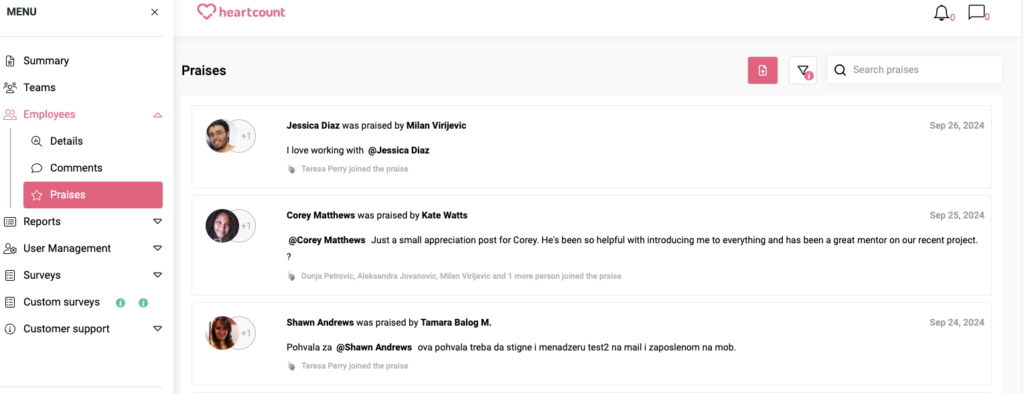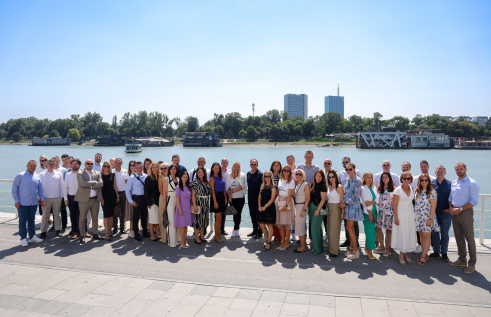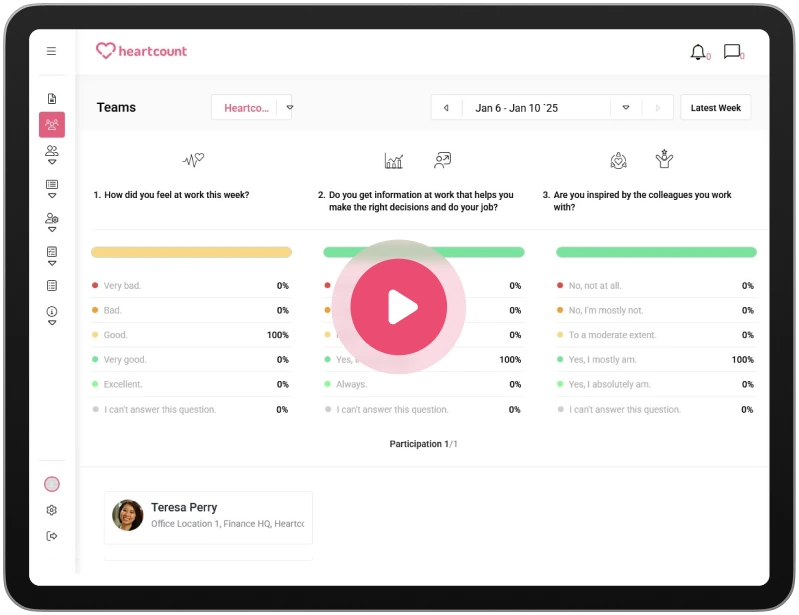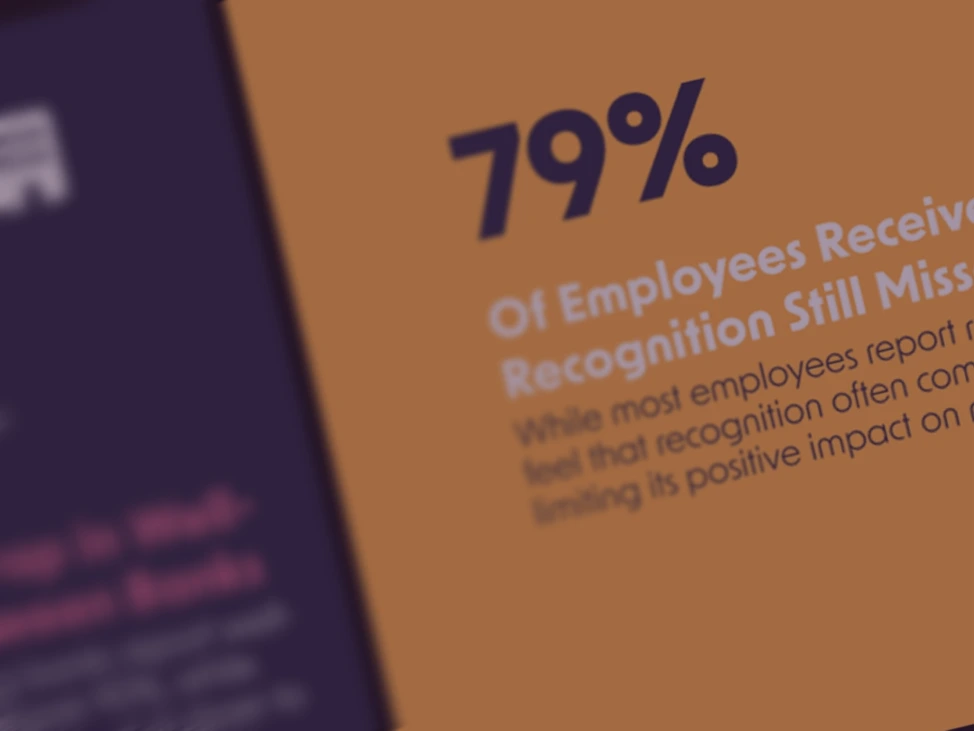How to create an employee recognition program template

Employee recognition program templates make it easier for HR experts by giving them a clear way to recognize employees fairly and consistently. In large companies, it’s hard to keep recognition the same across different teams or locations. Without a set system, it can feel uneven, and some people might think there’s favoritism.
Templates help by offering a fair way to recognize everyone based on clear rules. This makes it less likely that important contributions will be missed or that certain teams get all the attention. In the end, it helps you build trust and makes sure all employees feel appreciated.
Employee recognition program templates make it easier for HR experts by giving them a clear way to recognize employees fairly and consistently. In large companies, it’s hard to keep recognition the same across different teams or locations. Without a set system, it can feel uneven, and some people might think there’s favoritism.
Templates help by offering a fair way to recognize everyone based on clear rules. This makes it less likely that important contributions will be missed or that certain teams get all the attention. In the end, it helps you build trust and makes sure all employees feel appreciated.
What is an employee recognition program template?
Employee recognition program template is a valuable tool that helps HR teams design a consistent and fair way to recognize and reward employees for their hard work. Its structure outlines how and when your employees should be acknowledged.
There are several types of employee recognition that can be included in a program. Here are the most common ones you can implement:
Peer-to-peer recognition
Employees recognize and appreciate the efforts of their colleagues. You can do this through formal programs or informal shout-outs.
A real-life example of peer-to-peer recognition is the “Kudos” system used at companies like Google and Zappos. Employees give each other public praise, called “kudos,” for hard work or positive behavior.
These shout-outs are often shared on a company platform or in meetings. At Zappos, employees can also nominate coworkers for a small cash reward through the “Coworker Bonus Program.” This type of recognition boosts teamwork and creates a positive work culture.
Manager-to-employee recognition
This is direct recognition from a supervisor or manager, often highlighting an individual’s specific contributions or achievements.
IBM’s “Spot Bonus” program is a real-life example of manager-to-employee recognition. In this program, managers can quickly reward employees who go above and beyond.
Recognition often comes in the form of a small cash bonus, gift card, or public praise. It’s given right after the achievement, so employees feel appreciated in real time. This motivates employees and strengthens the bond between managers and their teams.
Public recognition
Recognition is given in front of others, such as during team meetings, company newsletters, or bulletin boards. This way, you can celebrate achievements more broadly within the company.
Salesforce uses “Top Performer” awards as an example of public recognition. Employees who excel are recognized at company-wide meetings or events. Their achievements are shared with the whole team, and they often receive a certificate or award. This boosts visibility, encourages others, and promotes a success-driven culture.
Private recognition
As a more personal form of acknowledgment, private recognition includes a one-on-one conversation or a personal note, which can still have a big impact.
One example of a company that uses personal recognition is Airbnb. Managers write private thank-you notes to employees, recognizing their individual contributions. These notes are specific and meaningful, helping employees feel appreciated and valued. This strengthens the bond between employees and managers.
Monetary recognition
Financial rewards like bonuses, raises, gift cards, or performance-based incentives.
Adobe’s recognition programs include both structured awards and flexibility for immediate, performance-based rewards. While specific details on a “Spot Awards” program are limited on public-facing sites, Adobe’s benefits platform highlights various rewards intended to acknowledge employee achievements promptly, with options for both monetary and non-monetary recognition.
Non-monetary recognition
Rewards that don’t involve money, such as certificates, extra time off, or symbolic awards like “Employee of the Month,” are profoundly effective as well.
Starbucks uses the “Bravo Award” program for non-monetary recognition. Employees showing great service or teamwork get the title. They are featured on a bulletin board, receive a plaque, and are recognized in team meetings. This boosts morale and motivates others.
Formal recognition
You can use structured programs with clear criteria, like annual awards or milestone celebrations (years of service or achieving certain goals).
Deloitte has a formal recognition program called “Applause Awards.” Employees are nominated for a great performance by peers or managers. Winners get a certificate and are recognized at company events. This program encourages excellence and highlights key achievements. Their employee recognition program is forever evolving to meet the needs of each and every individual.
Informal recognition
Provide spontaneous, casual praise, like a quick “thank you” or acknowledgment for a job well done.
Southwest Airlines is also known for using informal recognition. Employees frequently receive spontaneous praise or thank-yous from peers and managers. This informal recognition happens during team huddles or casual interactions, helping to build a supportive and positive workplace culture.
You can tailor each of these types to fit your company’s culture and the specific achievements that need to be recognized.
By using a template, you can ensure that recognition is handled fairly and regularly, which helps boost employee morale and engagement across all teams.
How to create an employee recognition program template?
Creating an employee recognition program template takes planning, but it’s worth it. Following the right steps makes the program fair, simple, and effective at boosting morale.
A clear system helps everyone understand how and when they’ll be recognized. This prevents confusion and keeps things consistent.
1. Set clear goals
The first step in creating an employee recognition program is to set clear goals. Without specific objectives, the program may lack direction and fail to get results.
For example, if your goal is to boost morale, focus on frequent, informal recognition to motivate employees. If the goal is to increase engagement, use public acknowledgment or peer-to-peer recognition to involve more team members.
To highlight behaviors that align with company values, recognize qualities like innovation or teamwork through formal awards or certificates.
Clear goals help decide which recognition methods to use, how often to apply them, and who should be involved. They also allow you to measure success and make adjustments as needed.
2. Define criteria for recognition
After setting the goals for your recognition program, the next step is to decide what actions or achievements will be rewarded. Being specific helps employees understand exactly what the company values and what behaviors to aim for.
This clarity avoids confusion and makes the process fair for everyone.
For example, if you’re rewarding performance, you might recognize employees who meet sales goals, finish projects early, or receive high customer ratings.
If teamwork is your focus, you could reward those who work well with others and support team success.
For creativity, you might acknowledge employees who suggest new ideas or improve processes.
3. Choose recognition methods
Choose the right methods that fit your company culture and employees’ preferences.
You can use public recognition in team meetings or company newsletters, where employees are praised in front of their peers. This can be motivating for employees who appreciate visibility. On the other hand, some may prefer private recognition. A personal thank-you note or a one-on-one acknowledgment from a manager can feel more meaningful.

The good news is that with HeartCount, you can implement and track all the options mentioned in the Employee Recognition module. You can give and receive praise publicly and privately, and you can gain insights via Employees Overview into who is most likely to give and receive praise.
You should also decide whether to use monetary or non-monetary rewards. Using a mix of both helps keep the program flexible and inclusive, catering to different preferences within the workforce. Non-monetary rewards are cost-effective and still impactful, while monetary rewards can provide an extra incentive for exceptional performance.
4. Set a schedule for recognition
It’s essential to plan how often recognition will occur. The timing of recognition—whether monthly, quarterly, or annually—should be based on your company’s needs and the behaviors or achievements you’re aiming to encourage.
Monthly recognition works well for more frequent accomplishments like hitting performance targets, whereas quarterly or annual recognition might be better suited for larger milestones, such as long-term projects or major contributions to company goals.
Having a regular schedule ensures that employees feel consistently appreciated and motivated. Regular recognition also prevents anyone from being overlooked.
Employees are more likely to stay engaged and productive when they know there will be consistent opportunities to be acknowledged. Whether it’s a quick monthly shout-out or an annual award ceremony, a clear recognition plan helps create a culture of appreciation and keeps morale high. By sticking to a schedule, companies show they prioritize employee well-being and performance on an ongoing basis.
5. Communicate the program to employees
Once your employee recognition template is ready, it’s crucial to share it clearly with everyone in the organization.
Begin by explaining the program’s purpose and how it aligns with company goals. Make sure employees understand the criteria for recognition so they know what achievements or behaviors will be rewarded. Whether it’s performance milestones, teamwork, or innovative ideas, being clear about what’s recognized helps employees know what to aim for.
Next, explain how recognition will be given—whether through public praise, private notes, or rewards like bonuses or certificates. Transparency in the process ensures employees understand how they can be acknowledged, fostering a sense of inclusion.
Clear communication keeps everyone motivated and engaged, knowing that their hard work won’t go unnoticed. This makes the program more effective and ensures employees feel valued and appreciated.
6. Collect feedback and adjust
After the recognition program has been running for a while, it’s important to gather feedback from both employees and managers. This will help you understand how well the program is working.
Ask employees if they feel the recognition is fair and meaningful, and ask managers if they find it easy to use and consistent. This feedback is crucial for spotting any areas that need improvement.
Once you have this feedback, use it to adjust the program as needed. You may need to change how often recognition occurs or to understand if certain achievements are being overlooked.
Regularly improving the program ensures it stays effective and continues to motivate employees.
Integrating templates into the current employee recognition program
Introducing a template into your existing recognition program can make it more organized and fair. Start by reviewing the current program to see what’s working and what isn’t.
You can tell an employee recognition program isn’t working well when employees stop feeling motivated or appreciated.
Signs include low morale, less engagement, or fewer employees participating in the program.
If recognition seems inconsistent and unfair, or if certain employees are being overlooked, it’s a sign the program needs improvement. Getting feedback from employees can also show where the program is falling short.
Once you pinpoint the strengths and weaknesses, design a template that fits your company’s goals and values.
Next, train managers and team leaders on how to use the template. This will help them apply it fairly and consistently. Make sure to explain the new process to all employees so they understand how recognition will work.
Finally, track how the new system is working and make changes if needed. This will ensure the template fits smoothly into your current program and helps improve it.
Benefits of having a template for employee recognition
Having a template for employee recognition helps create a system where employees are recognized fairly and consistently – no matter where they work or what team they’re on.
Poul Weihrauch, the CEO of Mars, has this to say about employee recognition “Your people are your biggest asset—show them you mean it”.
As much as he emphasizes the importance of growth and education in the workplace, there are, of course, many other perks at Mars that not only attract top talent but aim to retain them as one of their most valuable assets – in a well-organized manner, of course.
Let’s look at some of the key advantages of using a recognition template.
Ensures consistency in recognition
Having a template for employee recognition helps organizations keep things consistent across all departments and locations. Without a clear system, recognition can be different depending on the manager or team.
With incorporation of templates for employee recognition you can make sure that every employee is recognized and praised according to their contribution. That way you’ll be sure you’re creating fair and equal enviroment.
This is especially helpful for large companies with many branches, where it can be hard to keep recognition the same everywhere.
Reduces bias and favoritism
A structured template helps you stop bias and favoritism by setting clear rules for when and how recognition happens. You can make sure that recognition is based on the employee’s work, not personal relationships or opinions. When employees see that recognition is fair, they feel more valued and trust the organization more.
Saves time for HR and managers
A bespoke template enables you to make the process of recognizing employees faster and easier for HR and managers. Instead of figuring out how to recognize someone each time, they can follow the guidelines in the template. This saves time and effort, allowing you to focus on other tasks while still making sure employees are appreciated.
Boosts employee morale and engagement
When you give recognition fairly and regularly, it boosts employee morale. Employees feel happy and motivated when their hard work is noticed. A recognition template is there to make all employees, no matter their job, feel appreciated. As morale improves, so does engagement and job satisfaction.
Creates a stronger company culture
Using a template for employee recognition also helps you build a strong company culture. Regular recognition encourages behaviors that support company goals and values. Over time, this creates a workplace where your employees are motivated to do their best because they know their efforts will be noticed and appreciated.
Attracts and retains top talent
Employee recognition helps attract and retain top talent by making employees feel valued. When their work is appreciated, they feel motivated and satisfied. This builds loyalty and makes top performers want to stay longer. It also improves your company’s reputation, attracting skilled candidates who want to work in a positive environment. Regular recognition boosts morale and encourages engagement, helping your company keep its best people and draw in new talent.
Decreases costs
Employee recognition decreases costs by lowering employee turnover. Replacing an employee can cost you up to 150% of their salary. This includes recruiting, interviewing, hiring bonuses, and training.
When employees feel valued and appreciated, they are more likely to stay, reducing the need for expensive replacements. Recognition also boosts engagement and productivity, helping to avoid mistakes that could cost the company. Overall, keeping your employees happy through regular recognition saves money on recruitment and training while improving overall performance.
Reduces burnout
Employee recognition helps reduce burnout by fostering a positive work environment where your employees feel valued and appreciated. When employees are regularly acknowledged for their efforts, it boosts morale and motivation, which reduces stress. Feeling appreciated helps combat emotional exhaustion—a key factor in burnout—because it affirms that their work has meaning.
Recognition also promotes work-life balance by celebrating accomplishments, which can lead to your employees feeling more engaged and less overwhelmed. Studies show that employees who feel valued are less likely to experience the prolonged stress and disengagement associated with burnout.
To be fair, fairness is a top priority
Creating a structured employee recognition program template is essential for maintaining fairness and consistency in large organizations.
This approach ensures that recognition is given equitably, reducing the risk of favoritism and enhancing trust among employees. Setting clear guidelines also simplifies the process for managers, making it easier to celebrate achievements regularly and meaningfully.
Following clear steps and using templates tailored to different recognition types—whether peer-to-peer, manager-to-employee, or formal recognition—enables you to boost morale and build a positive work culture.
This can help you drive increased productivity, as employees are more motivated and committed to their work. Additionally, a supportive environment reduces turnover, as employees feel valued and are more likely to stay long-term, saving the company significant recruitment and training costs.
Integrating templates into existing programs also helps reduce bias, saves time, and encourages better engagement.
Regular recognition not only improves employee satisfaction but also reduces turnover, helping organizations retain top talent and lower costs. Over time, a well-run recognition program becomes a key part of driving company success.
Start improving employee engagement and satisfaction today with HeartCount’s real-time feedback and insights!







